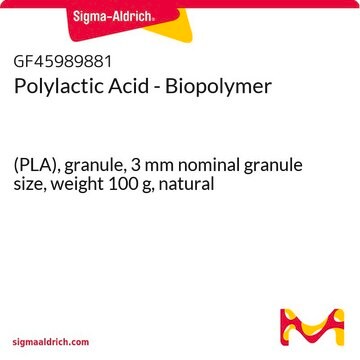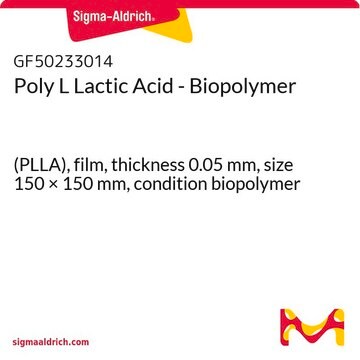38534
Polylactic acid
Mw ~60,000
Synonym(s):
Poly(2-hydroxypropionic acid)
Sign Into View Organizational & Contract Pricing
All Photos(1)
About This Item
Recommended Products
form
solid
shelf life
limited shelf life, expiry date on the label
mol wt
Mn ~30,000
Mw ~60,000
InChI
1S/C3H6O3/c1-2(4)3(5)6/h2,4H,1H3,(H,5,6)
InChI key
JVTAAEKCZFNVCJ-UHFFFAOYSA-N
Looking for similar products? Visit Product Comparison Guide
General description
Polylactic acid(PLA) is a biodegradable polyester synthesized from lactic acid monomer via ring opening polymerization. Owing to its excellent thermal, mechanical and barrier properties, it is widely used in the field of tissue engineering, drug delivery, and orthopedic devices.
Application
Polylactic acid can be used to prepare tubular scaffolds via the electrospinning method. These scaffolds are applicable in vascular tissue engineering.
It can be used to prepare PLA/polyvinyl alcohol wound dressing membrane through electrospinning and coating method. The coating of PLA improves the mechanical strength of nanofiber and acts as a protective layer to control the release of drug to the wound site.
It can also be used to synthesize free-standing, flexible ultra-thin PLA nanofilms which can act as a matrix for adhesion, spreading, and proliferation of skeletal muscle cells.
It can be used to prepare PLA/polyvinyl alcohol wound dressing membrane through electrospinning and coating method. The coating of PLA improves the mechanical strength of nanofiber and acts as a protective layer to control the release of drug to the wound site.
It can also be used to synthesize free-standing, flexible ultra-thin PLA nanofilms which can act as a matrix for adhesion, spreading, and proliferation of skeletal muscle cells.
Features and Benefits
- Biocompatibility
- Lower toxicity
- Low cost
- Better encapsulation
related product
Product No.
Description
Pricing
Storage Class Code
11 - Combustible Solids
WGK
WGK 3
Flash Point(F)
Not applicable
Flash Point(C)
Not applicable
Personal Protective Equipment
dust mask type N95 (US), Eyeshields, Gloves
Certificates of Analysis (COA)
Search for Certificates of Analysis (COA) by entering the products Lot/Batch Number. Lot and Batch Numbers can be found on a product’s label following the words ‘Lot’ or ‘Batch’.
Already Own This Product?
Find documentation for the products that you have recently purchased in the Document Library.
Customers Also Viewed
R M Felfel et al.
Materials science & engineering. C, Materials for biological applications, 33(4), 1914-1924 (2013-03-19)
Fibre reinforced composites have recently received much attention as potential bone fracture fixation applications. Bioresorbable composites based on poly lactic acid (PLA) and phosphate based glass fibre were investigated according to ion release, degradation, biocompatibility and mechanical retention profiles. The
Paul S Rosen et al.
Compendium of continuing education in dentistry (Jamesburg, N.J. : 1995), 34(1), 34-38 (2013-04-05)
This retrospective case series reports on the use of a polylactic acid barrier that was left exposed in the process of socket preparation for the placement of dental implants. A retrospective chart review found 43 patients with 48 extraction sockets
Huan Zhou et al.
Materials science & engineering. C, Materials for biological applications, 33(4), 2302-2310 (2013-03-19)
Fibrous bionanocomposites consisting of amorphous magnesium phosphate (AMP) nanospheres and polylactic acid (PLA) were fabricated by electrospinning. There are two important signatures of this paper. First, AMP, as an alternative to well-known calcium phosphate (CaP) materials, is added to PLA
Dah Hee Kim et al.
Carbohydrate polymers, 92(2), 1006-1011 (2013-02-13)
The purpose of this study is to evaluate the rheological and thermal properties of poly(l-lactic acid) (PLA) composites incorporated with microcrystalline cellulose (MCC) and lignin. The MCC/lignin/PLA composites were fabricated through direct melt compounding. In particular, the effect regarding the
G Faludi et al.
Carbohydrate polymers, 92(2), 1767-1775 (2013-02-13)
PLA biocomposites were prepared using three corn cob fractions and a wood fiber as reference. The composites were characterized by tensile testing, scanning electron microscopy (SEM) and polarization optical microscopy (POM). Micromechanical deformation processes were followed by acoustic emission measurements.
Our team of scientists has experience in all areas of research including Life Science, Material Science, Chemical Synthesis, Chromatography, Analytical and many others.
Contact Technical Service









